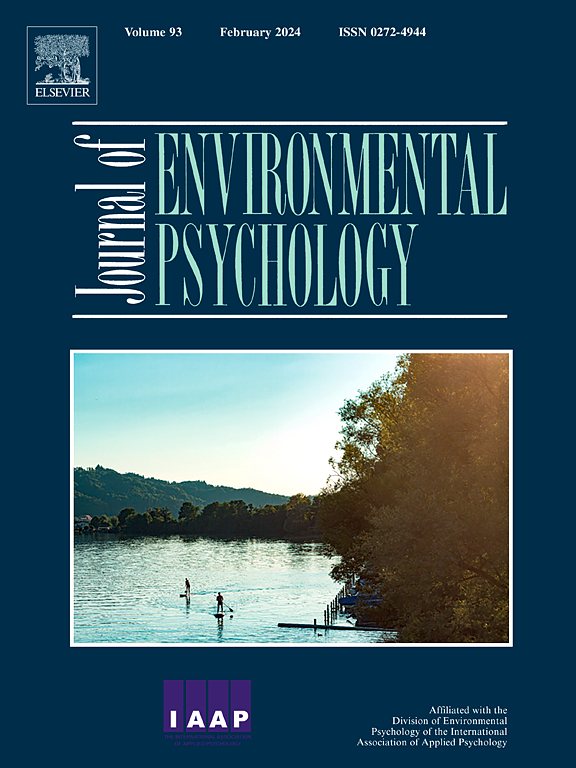The role of nature connectedness in facial dissatisfaction and body appreciation: The mediating effect of appearance-contingent self-worth in a cross-cultural context
IF 7
1区 心理学
Q1 ENVIRONMENTAL STUDIES
引用次数: 0
Abstract
Based on the goal-discrepancy theory, this research comprised two studies investigating the impact of nature connectedness on facial dissatisfaction and body image, along with its underlying mechanisms. Study 1 employed a between-subjects experimental design to establish the causal influence of nature connectedness. A total of 240 Chinese participants (119 males; with a mean age of 30.25 ± 7.73 years old) were randomly assigned to either a high or low nature connectedness condition. Results showed that participants in the high nature connectedness condition reported significantly lower levels of appearance-contingent self-worth and facial dissatisfaction, and higher body appreciation, confirming the mediating role of appearance-contingent self-worth in this causal pathway. Study 2 aimed to assess the generalizability of these findings across cultures using cross-sectional data from 350 Chinese participants (131 males, with a mean age of 30.09 ± 7.47 years old) and 342 American participants (125 males; with a mean age of 34.22 ± 12.09 years old). Multiple group structural equation modeling revealed that the mediating role of appearance-contingent self-worth was supported in both cultural groups; however, the strength of the associations differed significantly. These findings suggest that while the underlying mechanism is present across cultural contexts, its strength varies by culture. Taken together, these studies provide both causal and cross-cultural evidence that nature connectedness may improve body image by reducing appearance-contingent self-worth. The results also offer a theoretical basis for the development of culturally sensitive, nature-based interventions targeting body image concerns.
自然连通性在面部不满和身体欣赏中的作用:跨文化背景下外表自我价值感的中介作用
基于目标差异理论,本研究包括两项研究,探讨自然连通性对面部不满和身体形象的影响及其潜在机制。研究1采用被试间实验设计来确定自然连通性的因果影响。240名中国受试者(男性119人,平均年龄30.25±7.73岁)被随机分为高连接性组和低连接性组。结果表明,高自然连通性条件下的被试表现出较低的外表自我价值感和面部不满意感,而较高的身体欣赏感,证实了外表自我价值感在这一因果通路中的中介作用。研究2旨在利用来自350名中国参与者(131名男性,平均年龄为30.09±7.47岁)和342名美国参与者(125名男性,平均年龄为34.22±12.09岁)的横断面数据来评估这些发现在不同文化中的普遍性。多群体结构方程模型表明,在两种文化群体中,外表-偶然自我价值感的中介作用都得到了支持;然而,这种关联的强度差别很大。这些发现表明,尽管潜在的机制在不同文化背景下都存在,但其强度因文化而异。综上所述,这些研究提供了因果关系和跨文化的证据,证明自然联系可能通过降低外表的自我价值来改善身体形象。研究结果还为针对身体形象问题的文化敏感、基于自然的干预措施的发展提供了理论基础。
本文章由计算机程序翻译,如有差异,请以英文原文为准。
求助全文
约1分钟内获得全文
求助全文
来源期刊

Journal of Environmental Psychology
Multiple-
CiteScore
10.60
自引率
8.70%
发文量
140
审稿时长
62 days
期刊介绍:
The Journal of Environmental Psychology is the premier journal in the field, serving individuals in a wide range of disciplines who have an interest in the scientific study of the transactions and interrelationships between people and their surroundings (including built, social, natural and virtual environments, the use and abuse of nature and natural resources, and sustainability-related behavior). The journal publishes internationally contributed empirical studies and reviews of research on these topics that advance new insights. As an important forum for the field, the journal publishes some of the most influential papers in the discipline that reflect the scientific development of environmental psychology. Contributions on theoretical, methodological, and practical aspects of all human-environment interactions are welcome, along with innovative or interdisciplinary approaches that have a psychological emphasis. Research areas include: •Psychological and behavioral aspects of people and nature •Cognitive mapping, spatial cognition and wayfinding •Ecological consequences of human actions •Theories of place, place attachment, and place identity •Environmental risks and hazards: perception, behavior, and management •Perception and evaluation of buildings and natural landscapes •Effects of physical and natural settings on human cognition and health •Theories of proenvironmental behavior, norms, attitudes, and personality •Psychology of sustainability and climate change •Psychological aspects of resource management and crises •Social use of space: crowding, privacy, territoriality, personal space •Design of, and experiences related to, the physical aspects of workplaces, schools, residences, public buildings and public space
 求助内容:
求助内容: 应助结果提醒方式:
应助结果提醒方式:


